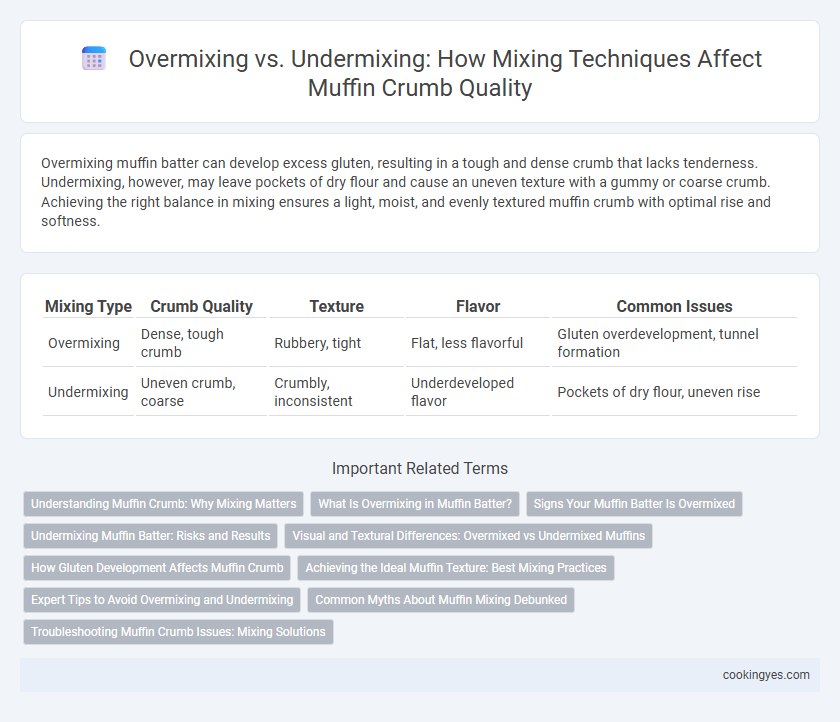Overmixing muffin batter can develop excess gluten, resulting in a tough and dense crumb that lacks tenderness. Undermixing, however, may leave pockets of dry flour and cause an uneven texture with a gummy or coarse crumb. Achieving the right balance in mixing ensures a light, moist, and evenly textured muffin crumb with optimal rise and softness.
Table of Comparison
| Mixing Type | Crumb Quality | Texture | Flavor | Common Issues |
|---|---|---|---|---|
| Overmixing | Dense, tough crumb | Rubbery, tight | Flat, less flavorful | Gluten overdevelopment, tunnel formation |
| Undermixing | Uneven crumb, coarse | Crumbly, inconsistent | Underdeveloped flavor | Pockets of dry flour, uneven rise |
Understanding Muffin Crumb: Why Mixing Matters
Mixing muffin batter correctly is crucial to achieving the ideal crumb texture; overmixing develops excessive gluten, resulting in a tough, dense crumb, while undermixing leaves pockets of dry flour causing uneven crumb and coarse texture. Proper mixing ensures the ingredients are just combined, producing a tender, moist, and uniform crumb structure. Understanding the balance between overmixing and undermixing directly impacts the muffin's lightness and overall quality.
What Is Overmixing in Muffin Batter?
Overmixing muffin batter occurs when too much stirring activates excess gluten development, resulting in a dense, tough crumb instead of a light, tender texture. This causes large tunnels or holes inside the muffin and a gummy mouthfeel, reducing overall quality. Proper mixing is crucial to balance gluten formation while maintaining moisture and softness in the muffin crumb.
Signs Your Muffin Batter Is Overmixed
Overmixed muffin batter often appears dense and tough, with a glossy surface indicating excessive gluten development. Bubbles may be fewer and irregular, resulting in a coarse, rubbery crumb instead of a tender, moist texture. Detecting these signs early helps ensure an ideal light and airy muffin crumb quality.
Undermixing Muffin Batter: Risks and Results
Undermixing muffin batter leads to uneven distribution of ingredients, resulting in a dense, coarse crumb with inconsistent texture. Insufficiently mixed batter prevents proper gluten development and leavening, causing muffins to rise poorly and have a gummy or heavy interior. Careful mixing ensures optimal crumb structure, balancing moisture retention and lightness for desirable muffin quality.
Visual and Textural Differences: Overmixed vs Undermixed Muffins
Overmixed muffins exhibit a dense, rubbery crumb with tunnels and peaked tops due to gluten overdevelopment, while undermixed muffins have uneven, coarse crumbs and flat, uneven surfaces from insufficient ingredient incorporation. Proper mixing achieves a tender, moist crumb with a light, uniform texture and a rounded, smooth top. Visual quality and crumb texture directly reflect the muffin batter's mixing time, impacting consumer satisfaction and baking consistency.
How Gluten Development Affects Muffin Crumb
Gluten development plays a crucial role in determining muffin crumb texture; overmixing leads to excessive gluten formation, resulting in a dense and tough crumb. Undermixing, on the other hand, limits gluten network development, producing a crumb that is crumbly and overly tender. Achieving optimal muffin crumb quality requires balanced mixing to develop enough gluten structure for a soft yet cohesive texture.
Achieving the Ideal Muffin Texture: Best Mixing Practices
Achieving the ideal muffin texture depends on precise mixing techniques that balance gluten development and ingredient incorporation. Overmixing muffin batter causes excess gluten formation, resulting in dense, tough crumbs, while undermixing leads to uneven crumb structure and large air pockets. The best practice blends ingredients until just combined, ensuring a tender, moist crumb with a uniform, desirable crumb quality.
Expert Tips to Avoid Overmixing and Undermixing
Achieving the perfect muffin crumb hinges on striking a balance between overmixing and undermixing the batter. Expert bakers recommend mixing just until the dry ingredients are incorporated to avoid overdeveloping gluten, which leads to tough, dense muffins, while undermixing can cause uneven texture and tunneling. Using gentle folding techniques and monitoring batter consistency can ensure a moist, tender crumb with uniform air pockets.
Common Myths About Muffin Mixing Debunked
Overmixing muffin batter does not always lead to a tough, dense crumb; gentle folding ensures gluten development without excessive toughness, contrary to popular belief. Undermixing, often blamed for poor texture, can result in uneven crumb and pockets of dry flour, misrepresenting the actual cause of muffin inconsistency. Understanding that moderate mixing balances gluten formation and ingredient integration debunks myths, ensuring optimal moistness and crumb quality in muffins.
Troubleshooting Muffin Crumb Issues: Mixing Solutions
Overmixing muffin batter leads to dense, tough crumbs due to gluten overdevelopment, resulting in tunnels and a rubbery texture. Undermixing causes uneven crumb structure and large air pockets, making muffins collapse or have a coarse texture. Achieving optimal mixing requires combining ingredients just until incorporated to produce a tender, uniform crumb with a balanced rise.
Overmixing vs Undermixing for muffin crumb quality Infographic

 cookingyes.com
cookingyes.com